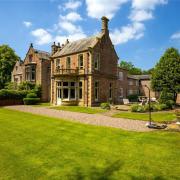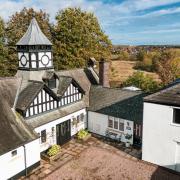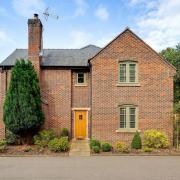The Barnston family of Cheshire can trace their history back to around the time of the Norman Conquest of 1066, when Hugh de Berneston settled in the Wirral peninsula, registering lands there and giving the family name to the village now known as Barnston.
By 1400, the Barnston Estate was established, further into what is now known as Cheshire, and has remained in the family ever since. Today, more than six centuries on, current guardian Ed Barnston has taken on the mantle with enthusiasm and fresh ideas.
One of these ideas is the redevelopment of Churton Hall, a 15th-century house in the village of Churton, near Chester. The house has been part of the Barnston Estate since it was built but within the long-term lease of a dairy farming family, who this year advised Ed that they no longer wished to renew their tenancy.

“The house and land were bound into a three-generation tenancy agreement, which was entered into just after the Second World War and ended in February 2023,’ Ed says. ‘The current generation decided they didn’t wish to renew, so it has reverted to the estate.”
It was thought the house was built in 1569, which is the date carved above the front door, but research now shows it dates to 1461.
“Churton Hall was gifted in 1569 as a wedding present to William Barnston and his wife Elizabeth,” Ed says. “Their initials, with the date, are on the front porch of the hall (accounting for the confusion over its origins). William’s grandson Robert Barnston was possibly the last Barnston to live at Churton Hall and thereafter it was a working farm.”

Once the tenant family had moved out of Churton Hall, Ed was able to go and assess the condition of the house and what opportunities might lie within for the estate.
“Nobody leaves school expecting they’ll be looking after such an historic building, with lots of outbuildings and a large walled garden – it's a unique opportunity to decide what we do with it next,” he says. “We could go back to the vanilla option – farming – but we had to ask: does the house deserve more? We brought in a heritage officer, a conservation office, and a dendrochronologist (an expert in the technique of dating by using the characteristic patterns of growth rings in timber and tree trunks). We know the house was a ‘hall house’ for dwelling, and, probably, for the administration of the hamlet. It’s been a working farmhouse ever since.
“When it came back into the estate, we stripped back wallpaper (layers and layers, cupboards, curtains, flooring, radiators, everything, taking it right back to its bones.’

“We got back to the lathe and plaster layer, and then behind this the original cob, a mix of soil, straw and horsehair packed between the beams to form the walls. In these walls are long rose stems too, with thick thorns, which we think were used to help hold it all together.
“For the first couple of months, every time we came here, we discovered something new.”
Ed brought in Kirsty Henderson, of Henderson Heritage, who carried out a detailed assessment of Churton Hall, which is Grade II listed.


Her report states that Churton Hall is a former cruck-framed hall house from the 15th century that has later and significant alterations dating from each subsequent century, all wrapped around an older timber core. The dendrochronologist found the oldest timbers in the house date back to the 1400s and are formed from oak grown from acorns planted in the 1300s. These oak beams may look frail, honeycombed with tiny holes and grooves, but they are in fact immensely strong, having been in place so long they have turned into iron oak, almost stone-like in texture.
This is not the only discovery Ed made – there was also an entire room sealed up.
“The last tenant’s mother believed she saw a ghost in her room,’ Ed says, ‘and after that, it was completely sealed off until we took back the building.”

Now that the house’s history has been brought to light, what does the Barnston Estate plan to do with it?
A whole new chapter is being written for this building and the accompanying farm buildings and gardens, and it’s something wholly contemporary and wholly in keeping with the estate’s philosophy – a trio of core values – Planet, People and Profit – that unite conservation, community and capital management, placing sustainability at the heart of every decision made.
“An extension was added to the medieval property in the 19th century,” Ed says. “We hope to take this and the original building and create two homes, which we will lease. The adjacent farm buildings – the old smithy, stabling, etc, could be developed into homes too, with shared office space to allow for working from home should residents wish. We plan to then redevelop the walled gardens into a care farm, where people facing challenges, both physical and mental, can come for just one day or for regular visits and engage in gardening and farming practices, providing positive outcomes for them. We’re looking at bringing in long horn cattle, planting an orchard, creating kitchen gardens. All produce will be organic, and we hope to link with the local community to donate to food banks or even local cafés, in the hope that they pay it forward in hot meals for the care farm workers.

“In hundreds of years of farming, it’s now the right time to be taking Churton Hall Farm in a new direction that fulfils our ethos of people, planet and profit – which is good for the environment through going organic and regenerative farming, encouraging biodiversity, working with the Cheshire Wildlife Trust and restoring ponds, and it’s good for the wider and local community too. Plus, we’re giving ancient buildings and land a new lease of life – but how we knit it all together, that’s the challenge.”
At the time of speaking, Ed’s plans are still very much on the drawing board. Planning permissions are being sought and the right partnerships are being explored.
“There are many things I am not,’ Ed says. ‘So we have to source the right people to form the key team of critical advisers. We have looked at multiple iterations of what it could be, we've examined how other estates are doing it – Rhug in North Wales and Dalesford in Oxfordshire, for example. Doing nothing is not an option.
“We cannot ignore a medieval house – it's a responsibility but also a unique opportunity. I have to get it right.”





























